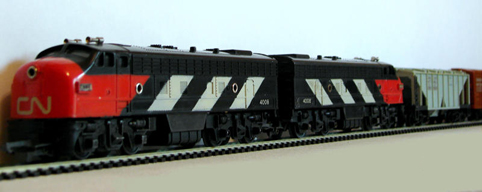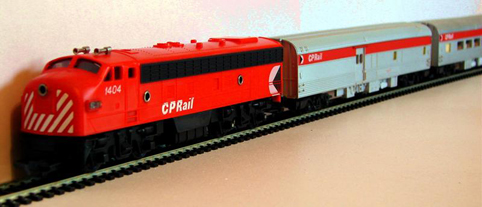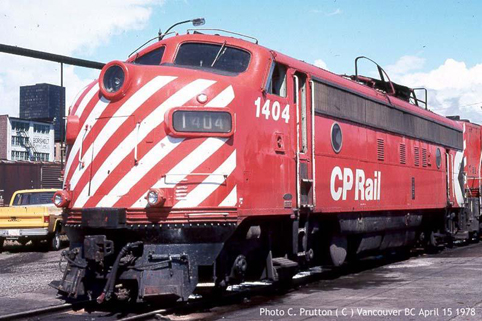Article
R.55 Single Ended Diesel – A toy or a model?
Author: John Faulkner
Date: 15 May 2010
Related Model: Canadian National Diesel Locomotive
As part of the original Transcontinental series of models Tri-ang Railways sought influence from the North American F7-A prototype. Prototype locomotives were built starting in the late 1940’s by General Motors for numerous railways in USA and Canada; including both the Canadian National and Canadian Pacific systems. Production units were configured as driving “A” units or slave “B” units for multi-vehicle operation. Although primarily designed for passenger operation the units soon found favour in freight use as well and they truly became the work-horses of many railways soon replacing out-dated steam locomotives.
The model designated catalogue number R55 was originally released in 1956 with the running number 4008. It appears the proto-type counter-part for 4008 was a Canadian Pacific FA-1 built by Montreal Loco Works in the early 1950’s. The FA-1 was similar in character appearance to F7’s as modeled by Tri-ang but the differences were far more than cosmetic.
In keeping with the prototype Canadian railways, Tri-ang produced both powered and dummy versions of the “A” unit as well as dummy versions of the “B” unit, all in a rather unconvincing “Tri-ang Railways” livery. All models were numbered 4008; however some “B” units may have been numbered 4009? This number appeared printed on the lower side at the back of the engine and in the illuminated side light boxes below the cab side windows. This allowed the modeler to recreate a semi-authentic lash-up of locomotives in keeping with the prototypes. However, to create an authentic lash-up of locomotives the over-all length could easily exceed 36” or one metre for an A-B-B-A arrangement, as used on a full length passenger trains; as the famous transcontinental passenger train “The Canadian”. The dummy “A” and “B” units were not big sellers and dropped from the range after 1962.
Although not accurate in scale or even ratio the over-all appearance was quite acceptable. Even in the “Tri-ang Railways” livery and the later “Transcontinental” variant the model colours bore a strong resemblance to the colour scheme in use at the time on the Canadian Pacific. The most obvious fault of the model was the high hood appearance and small windshields. However, the original Tri-ang series of passenger cars available at the time were less than convincing spoiling the effect of a modern image railway. Several train sets were produced with the F7 model, such as the RHX with very limited prototype appeal; possibly hampering potential sales? Competitors from the USA had far more realistic HO scale models already on the market. As Tri-ang’s target market was Canada there was already strong competition for the scale modeler; children on the other hand were not well catered for except by the large scale and robust O-gauge models of Lionel. Therefore, the success of Tri-ang was not in making an authentic scale model but rather a robust and usable small scale toy train set. To this end the model was a success and went on to sell large numbers for the intended Canadian market as well as in Britain and abroad.
By 1965, the Marketing Department of Rovex were compelled to increase lagging sales in Canada and in answer to consumer requests for authentic liveries a Canadian National variation was released in the then new and topical Canadian National red livery with white and black diagonal stripes. The result had a very satisfactory appearance and the model went on to be the most numerous of all F7 variations produced. The model appeared not only in the Canadian 1965 catalogue; but also various British and even Australian publications through the final year of Canadian model production in 1973. By the time the model was released in the Canadian National livery, a more suitable series of coaches was available to compliment the locomotive. Although the coaches were strongly influenced by the competitive Canadian Pacific proto-types, a very satisfying and semi-realistic train set formation could be made-up, minus the fore-mentioned obsolescence of the non-powered variants. Unfortunately Tri-ang chose not to paint the coaches in the more accurate white and black livery as shown in the pre-production models featured in the diorama used in both the 1965 and 1967 Canadian catalogues; but rather chose an injection molded silver grey colour, off-set with a painted black stripe. Interestingly the model running number remained unchanged as 4008.
By 1967 the outlook for running an authentic train headed by an F7 really took a leap forward for Canadian buyers. The model was released that year in authentic Canadian Pacific colours; again carrying the running number 4008 (although catalogue pictures show otherwise). A beautiful and quite authentic looking train set featured in the 1967 catalogue listed as TS.674 “The Canadian”. The real railway was soon to under-go a change of livery to action red making made the grey maroon livery obsolete. As the Canadian Pacific models were only available to the general public through Canadian retail outlets the Canadian Pacific models of the late 1960’s are the hardest to find and most collectable variants today.
As stated above; by 1969 Canadian Pacific was under-going a radical publicity change and proto-types were being re-painted in CP Rail “Action Red” livery. The first F7 to be repainted was 1404 in Montreal in July 1969. Interestingly when Tri-ang released their variant of the CP Rail livery the running number chosen this time was authentic, being none other than 1404. Although the printed number was changed the light box continued to display 4008, but this fault is easily over-looked. A complimentary set of passenger cars and freight wagons was produced making the 1970 Canadian catalogue a true feast of colourful and exciting models in keeping with the times. The CP Rail variants along with the previously released Canadian National models remained in the Canadian catalogues through the final 1973 printing.
By 1973, Tri-ang had been acquired by the Dunbee-Combex Marx Group of toy-makers. DCM tried to keep the product alive in Canada and even moved the company and inventory to their own head-quarters in Scarborough. Along with other models in the range; by 1973 the model was already nearly 20-years old. The models were technically out-dated, not to the predominant and established North American HO-scale, and not really compatible with the competitive offerings. As Hornby themselves were struggling to justify their British range it’s easy to see why the Canadian models were abandoned. After 1973 remaining stocks were liquidated but remained in retail shops for many years. Although no longer being given away at “Fire-sale” pricing; even today “new” models periodically show-up, often coming out of some long forgotten stock-room shelf.
What did make the model a success? The fact it was a Tri-ang product designed for enjoyment of school aged children. My personal collection features several variants; the oldest being the 1965 Tri-ang Railways Canadian National version which was given to me as a Christmas present in 1968. It was produced in March 1965, packaged in a Tri-ang Railways window box and shipped with an early Tri-ang Hornby instruction leaflet. As a boy the fun of Tri-ang was exemplified in this model by running it at speed in the dark hauling a high speed passenger consist. Running full throttle through first radius Super-4 curves caused many derailments but to see the glow of the head-light and side light boxes illuminate a darkened room as it came into the straight sections of rail and through the station is a thrill to be remembered even 40-years later. Even today a currently produced DC controlled with sound and lighting could not set out to replicate that experience. Tri-ang really did and still does have the fun segment of the market all to itself and never to be repeated. The F7 model was a significant part of that successful equation, to that end it was a true model and not just another toy.





















